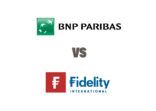Kiran Nandra Koehrer, Pictet Asset Management
During the past three weeks, the Pictet Asian Equities Ex-Japan Fund has increased its consumer exposure, with additions including China white goods manufacturers, China social networking names and regional travel booking providers, as well as healthcare and Taiwanese technology hardware stocks.
These purchases were funded by sales of a China oil producer and a China live-streaming company, an Indian financial and a South Korean technology hardware manufacturer, Kiran Nandra Koehrer, senior product specialist, emerging equities, at Pictet Asset Management, told FSA.
“Given the bottom-up and fundamental nature of our investment style, these positioning changes were less to do with any top-down views and more to do with our view on each stock’s risk-reward profile,” said Koehrer, who is a strategist for the $700m Asian equities ex-Japan product.
“We believed that the valuations of some consumer names only made sense on the assumption that Covid-19 would be a permanent impairment of the business model, whereas we have always taken the view that Covid-19 is transitory in nature,” she explained.
For example, some of the region’s travel-related names have sold off by around 40% this year, and by about 60% over a six-month period, partly due to Hong Kong’s political problems, she added.
Koehrer and the portfolio managers focus on cash generative companies whose valuations are compelling, and make selective purchases to help mitigate downside risk.
The Pictet strategy is similar to other Asian equity funds, such as the Aberdeen Standard Sicav I Asia Pacific Equity Fund.
Last week, Pruksa Iamthongthong, senior investment director, Asian equities at ASI, told FSA that the fund was “taking advantage of the recent sell-off in Asia-Pacific equities through discerning buying of stocks of companies which are market leaders in their sectors and whose structural long-term growth prospects remain intact”.
Early portfolio shifts
Meanwhile, the Pictet fund entered this month’s market crash with its largest overweight (compared with the index) to the consumer discretionary — mainly autos and components — and consumer durables sectors, as well as information technology (IT).
Its biggest underweights were to property, due to limited exposure to Hong Kong real estate, and to consumer staples.
“This was already a change from the start of the year as Covid-19 had changed the way the strategy was positioned. We began the year with a larger overweight to both IT and financials, and we trimmed our energy and utilities exposures in January and February and remain underweight energy,” said Koehrer.
The fund’s country allocation had also shifted just before the crisis, with a larger overweight to China, reduced exposure to India (although still overweight) and a bigger underweight position in South Korea, where the valuations of some leading names in the index are unappealing.
Relative outperformance
The fund has generated a positive three-cumulative return of 2.97%, compared with negative returns by both its category average (-7.12%) and its benchmark MSCI AC Asia ex-Japan index (-12.44%), according to FE Fundinfo data.
It has achieved alpha of 6.09 during the period, but its 19.9% annualised volatility is higher than its peers (16.29%) and its benchmark (18.17%).
Nevertheless, the fund has also held up relatively well so far this year. It is down 21.68%, but that is better than the sector (-26.50%) and benchmark (- 26.73%).
Koehrer attributes the fund’s comparative outperformance this year to stock selection within the industrials, property and communication services sectors.
She highlighted a company that provides property management services in China and has offered value-added services to people whose daily activities have been restricted by the Covid-19 containment measures.
“It is likely that the policy environment will continue to be supportive for these types of companies, which should also help the sector to move to a ‘higher price for better quality services’ model,” said Koehrer.
“Some of the larger cap higher quality stocks appear to have sold down due to forced selling by investors needing cash, whereas more illiquid and lower quality names have been harder to sell.
“From an allocation perspective, being underweight energy and overweight consumer discretionary was also additive to relative returns,”she added.
However, Koehrer does not intend “to make any knee-jerk reactions”.
For example, “China’s government is taking measured steps to stimulate the economy and we are seeing signs of a pick up in economic activity with high frequency data points (for instance railways, restaurants and retail sales) back to 80% normal,” she said.
“However, the possibility remains for a second iteration of the virus which is another source of risk.”
Nevertheless, the most resilient Asia-Pacific ex-Japan funds this year have tended to have high exposure to China and Hong Kong, and have avoided Asean.
On the other, only 38% of funds with explicit Greater China equities mandates have outperformed the MSCI China index, suggesting that active managers’ claims for superior stock selection abilities in difficult markets have limited substance.
The long term investment case for Asia ex-Japan equities remains intact and valid even though over the shorter-term we are likely to experience higher volatility and turbulence.
Pictet Asian Equities Ex-Japan Fund vs sector average and benchmark MSCI AC Asia index


















